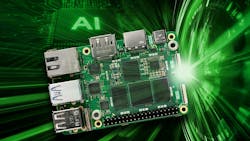GenioBoard Speeds Path to AI-Ready Computing Platforms
Grinn's GenioBoard highlights the rapid evolution of embedded systems toward AI-ready computing platforms. Smart devices are in higher demand across various industries, from industrial automation to consumer electronics, with manufacturers facing pressure to integrate AI capabilities without extending development time.
Pairing the new single-board computer (SBC) with the GenioSOM modules allows developers to achieve faster production for next-gen connected devices. The GenioBoard features an 87- × 56-mm footprint, ideal for developers who need connectivity and performance in a small space — essential for edge AI and IoT applications. Key features include:
- Single-cable USB development interface
- Single USB Type-C Power Delivery (PD) power supply
- Raspberry Pi HAT-compatible interface
- HDMI and DisplayPort (DP) interfaces
- 10/100/1000-Mb/s Ethernet PHY with RGMII interface
- Two USB-A 2.0 and two USB-A 3.0 interfaces
- USB-C to UART interfaces
- Two 4-lane CSI camera interfaces
- 4-GB RAM and 16-GB eMMC
It's also compatible with Grinn's GenioSOM-700 and -510 modules powered by MediaTek Genio processors. As a result, developers can scale between GPU, CPU, and NPU performance levels, depending on AI workload. This is practical as it means single boards support a variety of projects, from low-power sensor nodes to real-time vision systems, all without hardware stack reengineering.
The Shift to Accelerated Embedded-System Design
Launching the GenioBoard reflects a shift in embedded-system design driven by shorter development cycles and the complexity of AI products. With global competition intensifying, device manufacturers can no longer spend two to three years developing embedded products. Projects now take under a year to complete, starting from concept to prototype, causing engineers to rely on modular, application-ready compute platforms.
This acceleration redefines priorities for OEMs. Rather than building hardware and operating systems from scratch, teams rely on platforms that allow them to work on features like AI inference, edge analytics, or wireless connectivity. Grinn and other companies position their SOMs and boards as a response to this industry-wide shift, providing flexibility and speed when time-to-market is as important as performance.
“The Grinn GenioBoard provides the ideal tool to help OEM design engineers thrive in the new, more time-pressured environment that they find themselves in,” said Robert Otręba, CEO of Grinn. “It not only gives them an incredibly powerful MediaTek processor and all the fast interfaces they will need, Grinn also supports the hardware with essential software to get applications up and running. This includes a Linux operating system and the Thistle Security Platform for cybersecurity protection.
He added, “While other developers will be struggling to get custom hardware ready for the market, users of the GenioBoard can be working on their application’s software from Day One.”
Targeting production-ready applications rather than prototyping makes the GenioBoard more distinguishable from hobbyist-oriented SBCs like the Raspberry Pi. That change reflects a maturing embedded market with OEMs seeking long-term component availability, industrial-grade reliability, and regulatory compliance.
Integrating Linux prebuilt operating systems and obtaining CE certification reduces the lengthy validation process required before deployment. Including the Thistle Security Platform, built on Infineon's Trust M hardware module, highlights the importance of cybersecurity as a baseline requirement for manufacturers operating under new EU resilience regulations.
The design is also flexible. By integrating M.2 expansion for AI accelerators and wireless modules, Grinn realizes that device makers have planned for AI capabilities.
>>Check out more of our embedded world North America 2025 coverage
About the Author
Cabe Atwell
Technology Editor, Electronic Design
Cabe is a Technology Editor for Electronic Design.
Engineer, Machinist, Maker, Writer. A graduate Electrical Engineer actively plying his expertise in the industry and at his company, Gunhead. When not designing/building, he creates a steady torrent of projects and content in the media world. Many of his projects and articles are online at element14 & SolidSmack, industry-focused work at EETimes & EDN, and offbeat articles at Make Magazine. Currently, you can find him hosting webinars and contributing to Electronic Design and Machine Design.
Cabe is an electrical engineer, design consultant and author with 25 years’ experience. His most recent book is “Essential 555 IC: Design, Configure, and Create Clever Circuits”
Cabe writes the Engineering on Friday blog on Electronic Design.


